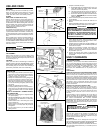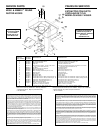
4
INSTALL RANGE HOOD
WARNING
TURN OFF THE PROPER CIRCUIT AT THE SER-
VICE ENTRANCE BEFORE WIRING THIS RANGE
HOOD.
1. Run electric wiring through hole drilled in wall or
cabinet. Split wiring for 6" and install proper con-
nector for type of wire used. (FIG. 9)
2. Position hood so that:
a.) Wiring is routed through knockout opening
(FIG. 10) (MX Series Only: Use grommet sup
plied in parts bag.)
b.) Large part of keyhole slots fit over hood mount-
ing screws. (FIG. 10)
c.) Damper/duct connector slides into ductwork.
(40000, 42000 and 42000D hoods only)
3. Adjust hood so that hood front is flush with cabi-
net frame.
4. Tighten hood mounting screws firmly.
5. Fasten wiring to hood with proper electrical con-
nector for type of wire being used.
WARNING
ALL ELECTRICAL CONNECTIONS MUST BE IN
ACCORDANCE WITH LOCAL CODES, ORDI-
NANCES, OR NATIONAL ELECTRICAL CODE. IF
YOU ARE UNFAMILIAR WITH METHODS OF IN-
STALLING ELECTRICAL WIRING, SECURE THE
SERVICES OF A QUALIFIED ELECTRICIAN.
6. Strip 1/2" of insulation from wires. Connect white
to white, black to black, and green to prepared
hole with green ground screw provided. (FIG. 11)
7. Replace wiring box cover and screw. Make sure
that all wiring is safely contained inside.
8. Install light (75 Watt maximum). For easier instal-
lation, squeeze plastic lens and remove it from
hood. Remember to reinstall lens. (FIG.12)
9. Turn on power and check operation of fan and
light. Make sure that damper operates freely.
INSTALL THE
DUCTWORK
(This section for 40000 and 42000 hoods only. 41000
hoods skip this section and go on to “Install Range
Hood”.)
NOTE
These instructions will follow plans made on
Page 2. Start at the exterior and run ductwork
back to the range hood.
For best possible performance, use the short-
est possible duct run and a minimum number
of elbows. Do not vent a range hood into an at-
tic space. A buildup of grease in the attic could
become a fire hazard.
Use only metal ductwork. DO NOT USE PLAS-
TIC DUCT. Assemble duct run securely so that
in case of a grease fire on the range, the fire
will be contained inside metal ductwork.
Tape all duct connections.
1. Follow appropriate directions below for type of duct
run you install.
a.) Wall Cap Discharge; (FIG. 7) Use saber saw
or keyhole saw to cut hole slightly larger than
duct size used so that duct will line up easily
with damper/duct conector on hood. Install
casing strips if cap will be installed on siding.
Attach required amount of duct to wall cap and
run duct back to hood. Fasten cap to wall and
caulk well.
b.) Roof Cap Discharge; (FIG. 8) Cut a hole in
roof slightly larger than duct size being used.
Run ductwork down to hood location. Leave
3/4" of duct projecting above roof surface on
high side.
Trim duct parallel to roof pitch and seal all
around duct with roof cement.
Carefully trim shingles and slide back of roof
sheet under shingles. Nail roof sheet to roof un-
der shingles at top two corners and two sides.
Nail sheet directly to roof in four places at bot-
tom.
Using roof cement, seal all nail heads and
shingles which were cut or lifted. Do not seal
bottom edge of roof sheet.
FIG. 5A
KEYHOLE SLOT OUTLINE
CONTORNO DE LA RANURA
FILLER STRIPS
PIEZAS DE MADERA
ROOF CAP
CASQUETE DE
TECHO
DUCT
DUCTO
SOFFIT
PLAFON
CABINET
GABINETE
FIG. 6
FIG. 7
CABINET
GABINETE
FIG. 8
CENTER
LINE
LINEA DE
CENTROS
SOFFIT
PLAFON
WALL CAP
CASQUETE
DE PARED
3/4"
3/4PLG.
INSTALACION DEL DUCTO
(Esta sección es solamente para los extractores
modelos 40000 y 42000. Los modelos 41000 pueden
saltarse ésta sección y continuar en la “INSTALACION
DEL EXTRACTOR”.)
NOTA
Estas instrucciones seguirán los planes descritos
en la pág 2. Comience a trabajar del exterior al in-
terior para conectar el ducto con el extractor.
Para obtener un mejor funcionamiento del extrac-
tor, procure que la salida del ducto sea la más
directa y que tenga el menor número de codos.
No permita que la salida del extractor quede en un
desván. Si se forma una capa de grasa en el desván
puede ser peligroso y causar un incendio.
Utilice solamente ductos de metal. NO USE
DUCTOS DE PLASTICO. Ensamble el ducto
firmemente para que en caso de que se prenda
debido a la grasa, el fuego se contenga dentro del
ducto de metal. Coloque cinta de aislar en todas
las conexiones del ducto.
1. Siga las incicaciones adecuadas para el tipo de ducto
que vaya a instalar.
a.) Salida del casquete de pared: (FIG. 7) Utilice
un serrucho o una sierra de calador para cortar
un orificio un poco más grande que el tamaño
del ducto, para poder acomodar facilmente el
ducto con el conector del ducto/regulador en el
extractor. Si el casquete se va a instalar en un
lado, instale las tiras del marco. Fije la cantidad
requerida del ducto en el casquete de pared y
acomode el ducto en el extractor. Ajuste el
casquete a la pared. Fijelo con un martillo. (Si la
pared es de concreto u otro material, ejecute las
operaciones necesarias para obtener los mismos
resultados.)
b.) Salida del casquete por el techo: (FIG. 8) Haga un
orificio en el techo, ligeramente más grande que
la circunferencia del ducto que se está usando.
Coloque el ducto debajo del lugar donde va el
extractor. Deje que 3/4 plg. del ducto sobresalgan
por encima de la superficie en el lado alto del techo.
Ajuste el ducto paralelamente con la inclinación
del techo y selle alrededor del tubo con cemento
para techos o tejados.
Empareje las tejas con cuidado y deslice la placa
del tejado que está debajo de las tejas. Clave la
placa del tejado a la parte de techo que está
bajo las tejas en las dos esquinas y los dos
lados superiores. Clave la placa directamente
al tejado en cuatro extremos en la parte inferior.
Utilizando cemento para tejado, selle todas las
cabezas de los clavos y las tejas que fueron
cortadas o levantadas. No selle el extremo infe-
rior de la placa del tejado. (Si el techo es de
concreto haga las operaciones necesarias para
obtener los mismos resultados.)
INSTALACION
DEL EXTRACTOR
ADVERTENCIA
DESCONECTE EL CIRCUITO EN LA ENTRADA DE
SERVICIO ANTES DE CONECTAR EL CABLEADO
DEL EXTRACTOR.
1. Pase el cableado eléctrico a través de un orificio en
la pared o el gabinete. Separe el cableado a 6 plg. e
instale el conector apropiado para el tipo de cable
usado. (FIG. 9)
HOOD WIDTH
ANCHO DEL EXTRACTOR
CENTER LINE
LINEA DE CENTROS
FILLER
STRIP
PIEZA DE
MADERA
**10-15/16" FOR 24" RANGE HOOD
10-15/16 PLG. PARA EXTRACTOR DE 24 PLG.
13-15/16" FOR 30" RANGE HOOD
13-15/16 PLG. PARA EXTRACTOR DE 30 PLG.
16-15/16" FOR 36" RANGE HOOD
16-15/16 PLG. PARA EXTRACTOR DE 36 PLG.
19-15/16" FOR 42" RANGE HOOD
19-15/16 PLG. PARA EXTRACTOR DE 42 PLG.
FIG. 5B
40000 AND 41000
MODELOS 40000
Y 41000
42000
MODELO 42000
























